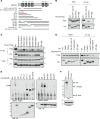Disease-associated AIOLOS variants lead to immune deficiency/dysregulation by haploinsufficiency and redefine AIOLOS functional domains
- PMID: 38015619
- PMCID: PMC10836806
- DOI: 10.1172/JCI172573
Disease-associated AIOLOS variants lead to immune deficiency/dysregulation by haploinsufficiency and redefine AIOLOS functional domains
Abstract
AIOLOS, also known as IKZF3, is a transcription factor that is highly expressed in the lymphoid lineage and is critical for lymphocyte differentiation and development. Here, we report on 9 individuals from 3 unrelated families carrying AIOLOS variants Q402* or E82K, which led to AIOLOS haploinsufficiency through different mechanisms of action. Nonsense mutant Q402* displayed abnormal DNA binding, pericentromeric targeting, posttranscriptional modification, and transcriptome regulation. Structurally, the mutant lacked the AIOLOS zinc finger (ZF) 5-6 dimerization domain, but was still able to homodimerize with WT AIOLOS and negatively regulate DNA binding through ZF1, a previously unrecognized function for this domain. Missense mutant E82K showed overall normal AIOLOS functions; however, by affecting a redefined AIOLOS protein stability domain, it also led to haploinsufficiency. Patients with AIOLOS haploinsufficiency showed hypogammaglobulinemia, recurrent infections, autoimmunity, and allergy, but with incomplete clinical penetrance. Altogether, these data redefine the AIOLOS structure-function relationship and expand the spectrum of AIOLOS-associated diseases.
Keywords: Adaptive immunity; Immunology; Molecular genetics; Monogenic diseases.
Conflict of interest statement
Figures








